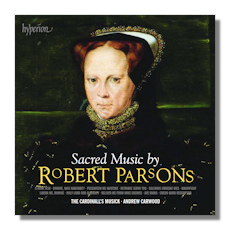
The Internet's Premier Classical Music Source
Related Links
- Parsons Reviews
- Latest Reviews
- More Reviews
-
By Composer
-
Collections
DVD & Blu-ray
Books
Concert Reviews
Articles/Interviews
Software
Audio
Search Amazon
Recommended Links
Site News
 CD Review
CD Review
Robert Parsons

Sacred Music
- Retribue Servo Tuo
- Responds for the Dead:
- Peccantem me, quotidie
- Libera me
- redo
- O bone Jesu
- Magnificat
- Domine Quis Habitabit
- Deliver me from mine enemies
- Ave Maria
- Iam Christus Astra Ascenderat
- Holy Lord God Almighty
The Cardinall's Musick/Andrew Carwood
Hyperion CDA67874
This is a CD of gentle, beautiful and deeply affecting music by the sixteenth-century English composer, Robert Parsons, who lived from c.1535 to 1572. It's sung with great lightness, yet expressive depth by specialists in the field, The Cardinall's Music, under their director Andrew Carwood. We don't know a great deal about Parsons. Like Byrd, he seems to have been associated with the eastern counties of England; and he drowned in the River Trent.
Parsons' music is less florid, somewhat more uniform and less texturally ambitious than that of Tallis or Byrd. The excellent booklet that comes with this CD sets out what is known about the composer's (surviving) works. His "Great Services" are among the few works otherwise available on CD other than in anthologized collections. So this issue is a very welcome one. Carwood is of course completely at home in the liturgical world into which all dozen or so works here fit.
They were written for specific occasions and/or for wider regular use. The texts (all reprinted in the booklet, with translations) are mostly in Latin, although Holy Lord God Almighty [tr.3] and Deliver me from mine enemies [tr.4] reflect, if nothing else, the fact that Parsons lived through times when approved forms of worship paralleled the transition from Protestantism, through the Marian Counter Reformation, back to Elizabethan Protestantism. In all cases, The Cardinall's Music articulates the words clearly and with a somewhat doleful expressiveness… Parsons does not appear to have led too joyous a life.
Yet to do this music justice, singers must on the one hand establish a distance between the composer as he perhaps struggles to exclude his personality and illuminate the devotional texts; and they should faithfully convey the spirit of his attitude to what – in Parsons' case – were difficult and disturbing times on the other. Parsons' music lacks the serenity that characterizes Tallis and Byrd and Parsons' own contemporaries, Tye, Sheppard and Mundy. It has a solemnity and dour tone to it but one that always steers well clear of the maudlin. Nor is there the sense of pity or deploration that characterizes many composers working in continental Europe at the time.
The 18 members of The Cardinall's Music are fully in step with the requirements that such tristesse not be overplayed, and at the same time not minimized. The pace of each piece is kept up; the structures and lines of text are fully exposed without fracturing our appreciation of the music's texture and impact as devout words set to beautiful music. Typical of this blend of text, emotion, music and balance (between the melancholy and certainty so common in Parsons) is the O bone Jesu [tr.10]: there is nothing histrionic about The Cardinall's Music's approach. But neither is there plainness or understatement. Nor even mere "statement", simple exposition of the ten-minute long work. Each line is clear; the mesh which each line makes with the others is pleasing; the sense of architecture, of moving from a position of prayer, supplication ("Good Jesus, enlighten my eyes…") to an evident state where – as the long lines untwine – the implorer's right to ask for such bounty is all but unchallenged. This is confidence in singing, in tempi and in an affection for the words. The Cardinall's Music are expert at this: without draining the life from the marriage of melody and words, they retain a detachment which is easy on the ear and mind. Yet fully stimulating.
The acoustic of this CD is everything that we expect from the roomy yet contained Fitzalan Chapel at Arundel Castle in Sussex (UK). The Cardinall's Music brings out as much of the differences between the (types of) Parsons's music on this CD as its similarities such that this must be considered one of fewer than half a dozen essential collections of music by the composer. Another Hyperion winner.
Copyright © 2011, Mark Sealey.





















